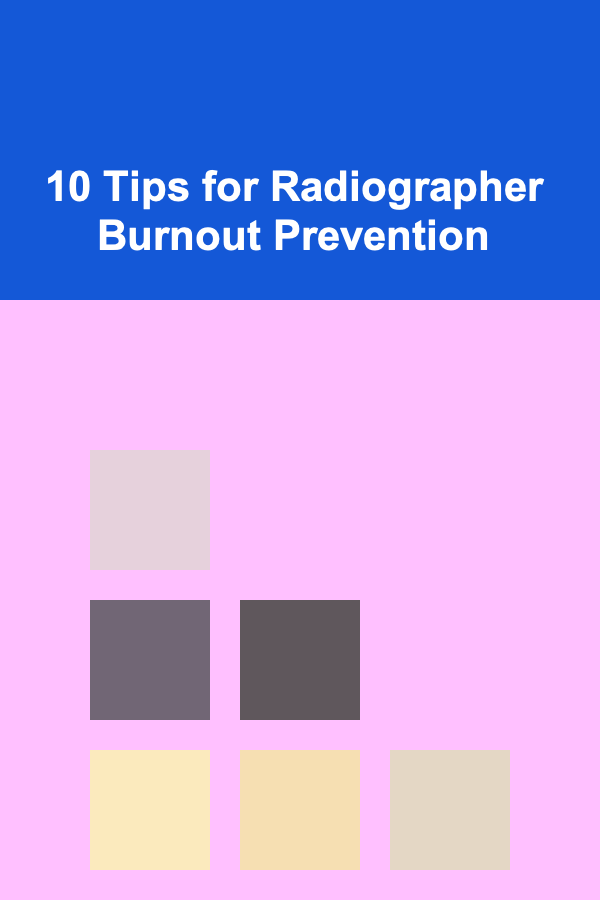
10 Tips for Radiographer Burnout Prevention
ebook include PDF & Audio bundle (Micro Guide)
$12.99$10.99
Limited Time Offer! Order within the next:

Radiographers play a crucial role in healthcare, using advanced imaging techniques to help diagnose and treat patients. They are responsible for operating complex machinery, ensuring patient safety, and providing critical images that aid in medical decision-making. While this job is rewarding, it can also be extremely stressful, with long hours, high-pressure situations, and physically demanding tasks. This constant strain can lead to burnout---a state of emotional, mental, and physical exhaustion caused by prolonged stress.
Burnout not only affects the well-being of radiographers but can also impact patient care and the efficiency of healthcare facilities. Preventing burnout is essential for maintaining a healthy, productive workforce. In this article, we will discuss 10 effective strategies for radiographers to prevent burnout, ensuring that they can continue to provide high-quality care without compromising their own health.
Recognize the Signs of Burnout Early
The first step in preventing burnout is recognizing the warning signs. Burnout often develops gradually, with symptoms that can range from physical fatigue to emotional exhaustion. Early detection is key to addressing the issue before it becomes overwhelming.
Symptoms to Watch For:
- Physical fatigue: Constant tiredness or lack of energy, even after rest.
- Emotional exhaustion: Feeling emotionally drained or detached from your work.
- Irritability or frustration: Increased irritability with patients, colleagues, or supervisors.
- Decreased job satisfaction: A noticeable decline in enthusiasm or motivation for your work.
- Cognitive overload: Difficulty concentrating, memory lapses, or making more mistakes than usual.
- Increased absenteeism: Taking more sick days or calling in sick more frequently than usual.
By paying attention to these signs and addressing them early, radiographers can prevent burnout from reaching a crisis point.
Implement Time Management Strategies
Radiographers often work in high-pressure environments where time management is crucial. A lack of proper time management can lead to feeling overwhelmed and stressed, which can contribute to burnout. Learning how to manage time effectively can help alleviate stress and create a better work-life balance.
Time Management Tips:
- Prioritize tasks: Focus on the most urgent and important tasks first. Create a daily or weekly schedule to organize your workload and set realistic deadlines.
- Break tasks into smaller chunks: Large tasks can feel overwhelming. Breaking them down into smaller, manageable steps helps maintain focus and prevents procrastination.
- Delegate when possible: Don't be afraid to ask for help when necessary. Whether it's asking a colleague for assistance or delegating a non-essential task, sharing the workload can reduce stress.
- Use technology: There are numerous tools and apps that can help with time management. Use them to set reminders, track tasks, and create efficient workflows.
Effective time management allows radiographers to feel more in control of their day and reduces the pressure of constantly running behind.
Foster a Supportive Work Environment
One of the most important factors in preventing burnout is having a supportive work environment. Radiographers often work in teams, and a positive, collaborative atmosphere can help reduce stress. When radiographers feel supported by their colleagues and supervisors, they are less likely to experience burnout.
Tips for Fostering Support:
- Communication: Open and honest communication between colleagues and supervisors helps prevent misunderstandings and fosters a collaborative atmosphere.
- Team-building activities: Participate in team-building exercises or social events that strengthen relationships among colleagues and create a sense of community.
- Provide feedback: Regular feedback, both positive and constructive, helps radiographers understand their strengths and areas for improvement. Feeling appreciated and recognized for their hard work can boost morale and reduce feelings of inadequacy.
By creating a positive work environment, radiographers can find camaraderie in their colleagues, which helps alleviate stress and build resilience against burnout.
Take Regular Breaks
Radiographers often work long hours, sometimes standing for extended periods while operating equipment or assisting with patient care. This can lead to physical exhaustion, mental fatigue, and eventually burnout. Taking regular breaks is essential for recharging both physically and mentally.
Break Strategies:
- Short, frequent breaks: Take a five- to ten-minute break every hour to stretch, walk around, or simply rest. Short breaks can help refresh the mind and body.
- Lunchtime breaks: Make sure to take a proper lunch break away from work. Use this time to relax, eat nutritious food, and recharge your energy levels.
- Relaxation techniques: During breaks, engage in activities that reduce stress, such as deep breathing exercises, stretching, or mindfulness meditation.
By incorporating regular breaks into the workday, radiographers can maintain their energy levels and avoid the build-up of fatigue.
Prioritize Self-Care
Self-care is crucial for anyone working in a high-stress environment, especially for radiographers who regularly deal with physical and emotional demands. Taking care of one's physical, emotional, and mental health is an essential part of preventing burnout.
Self-Care Practices:
- Exercise: Regular physical activity, such as walking, yoga, or strength training, helps reduce stress, improve mood, and boost overall health.
- Sleep: Adequate rest is essential for recovery and maintaining focus. Ensure that you are getting enough sleep, typically between seven to nine hours per night.
- Nutrition: Eating a balanced diet that includes plenty of fruits, vegetables, whole grains, and lean proteins can improve energy levels and mood.
- Hobbies and relaxation: Engage in activities outside of work that you enjoy, whether it's reading, gardening, spending time with family, or pursuing a creative outlet.
Prioritizing self-care not only helps prevent burnout but also improves job satisfaction and overall well-being.
Set Boundaries
Radiographers are often asked to work long hours, including overtime, and may face pressure to take on additional responsibilities. However, it is important to set boundaries to prevent becoming overwhelmed by excessive work demands.
Boundary-setting Tips:
- Know your limits: Be aware of how much work you can handle without sacrificing your health or well-being. If you feel overwhelmed, it's okay to say no or request additional help.
- Set work-life balance: Make sure that work doesn't dominate your personal life. Set specific times for work and times for personal activities to ensure that you have time to relax and recharge.
- Avoid over-committing: Be mindful of the tasks you agree to take on. Over-committing to projects can increase stress and lead to burnout.
Setting boundaries helps radiographers maintain a healthy balance between their professional and personal lives, reducing the risk of burnout.
Seek Professional Support
If burnout symptoms become too severe or persistent, seeking professional help may be necessary. Mental health professionals, such as counselors or therapists, can help radiographers develop coping strategies and address any underlying issues contributing to burnout.
Types of Professional Support:
- Counseling: Speaking to a therapist or counselor can help radiographers process their feelings, manage stress, and gain perspective on their work-related challenges.
- Employee Assistance Programs (EAPs): Many healthcare organizations offer EAPs, which provide confidential counseling and support services to employees. Radiographers should take advantage of these services if available.
- Support groups: Joining a support group for healthcare professionals can provide a sense of community and a space to share experiences and coping strategies.
Seeking professional support is not a sign of weakness but rather a proactive step in preventing burnout and maintaining mental health.
Engage in Continuing Education
Radiographers can sometimes experience burnout due to a lack of professional development or feeling stagnated in their careers. Engaging in continuing education and pursuing new skills can provide a sense of accomplishment, boost self-esteem, and reduce burnout.
Continuing Education Opportunities:
- Workshops and conferences: Attend workshops, seminars, and conferences to stay updated on the latest trends in radiography and healthcare technology.
- Certifications: Pursue certifications in specialized areas of radiography, such as MRI, CT scans, or ultrasound. This can increase job satisfaction and provide a sense of professional growth.
- Online courses: Many online platforms offer courses that allow radiographers to learn new skills or advance their knowledge at their own pace.
Engaging in continuing education helps radiographers stay motivated and gives them a sense of purpose and accomplishment in their careers.
Encourage Open Communication with Supervisors
Open and transparent communication with supervisors can help radiographers express their concerns and address issues before they lead to burnout. Supervisors can offer support, provide feedback, and help with workload management.
Communication Tips:
- Regular check-ins: Have regular one-on-one meetings with supervisors to discuss workload, challenges, and job satisfaction. This allows for early identification of any stressors and the opportunity to address them.
- Express concerns respectfully: If you are feeling overwhelmed or stressed, communicate this to your supervisor in a respectful and professional manner. They may be able to adjust your workload or offer additional support.
- Ask for support: If you need help with a difficult task or situation, don't hesitate to ask for assistance. Supervisors are there to support you and can help prevent burnout by providing the resources you need.
By fostering open communication with supervisors, radiographers can address concerns early and prevent burnout before it becomes overwhelming.
Cultivate Resilience
Building resilience is one of the most effective ways to prevent burnout. Resilience allows radiographers to bounce back from stressful situations and continue to perform at a high level, even in the face of challenges.
Resilience-building Strategies:
- Maintain a positive outlook: Try to focus on the positives, even in stressful situations. Reflect on past successes and use those experiences to help you navigate current challenges.
- Learn from setbacks: Instead of seeing mistakes or setbacks as failures, view them as learning opportunities. Each challenge faced is a chance to grow and improve.
- Develop coping strategies: Build a toolkit of coping strategies, such as mindfulness, deep breathing, or talking to a colleague, to manage stress effectively.
Cultivating resilience helps radiographers navigate the inevitable stresses of their profession while maintaining their well-being and avoiding burnout.
In conclusion, burnout prevention is a proactive, ongoing process that requires attention to mental, physical, and emotional health. By recognizing the signs of burnout early, implementing effective time management strategies, fostering a supportive work environment, and prioritizing self-care, radiographers can maintain a healthy work-life balance and continue to provide excellent patient care. With the right tools and mindset, radiographers can reduce the risk of burnout and sustain their passion for their work over the long term.
Reading More From Our Other Websites
- [Small Business 101] Best Subscription Box Models for Small Craft & Handmade Brands
- [Personal Care Tips 101] How to Make Your Deodorant Last Longer Throughout the Day
- [Organization Tip 101] How to Create a Time Capsule for Your Child's Room
- [Home Pet Care 101] Creating a Safe and Stimulating Environment for Your Pet Bird
- [Organization Tip 101] How to Create a Budget for Holiday Spending
- [Organization Tip 101] How to Store Jewelry in Your Closet Without Tangling
- [Organization Tip 101] How to Keep Office Decor Simple Yet Stylish
- [Horseback Riding Tip 101] From Lessons to Competitions: A Step-by-Step Roadmap for Your Child's Riding Journey
- [Reading Habit Tip 101] Best Ways to Use Public Libraries and Community Events to Sustain a Vibrant Reading Habit
- [Star Gazing Tip 101] Post-Processing Secrets: Turning Raw Night Sky Images into Stellar Masterpieces

How to Incorporate Vintage Decor Into Your Home Without Spending a Fortune
Read More
How to Use Technology to Stay Organized as a Senior
Read More
How to Navigate the Cosmopolitan Vibes of Sydney
Read More
How To Live a Life of Inquiry
Read More
The Step-by-Step Guide to Creating a Cozy Home
Read More
10 Tips for Scrapbooking Planner Stickers and Embellishments
Read MoreOther Products

How to Incorporate Vintage Decor Into Your Home Without Spending a Fortune
Read More
How to Use Technology to Stay Organized as a Senior
Read More
How to Navigate the Cosmopolitan Vibes of Sydney
Read More
How To Live a Life of Inquiry
Read More
The Step-by-Step Guide to Creating a Cozy Home
Read More